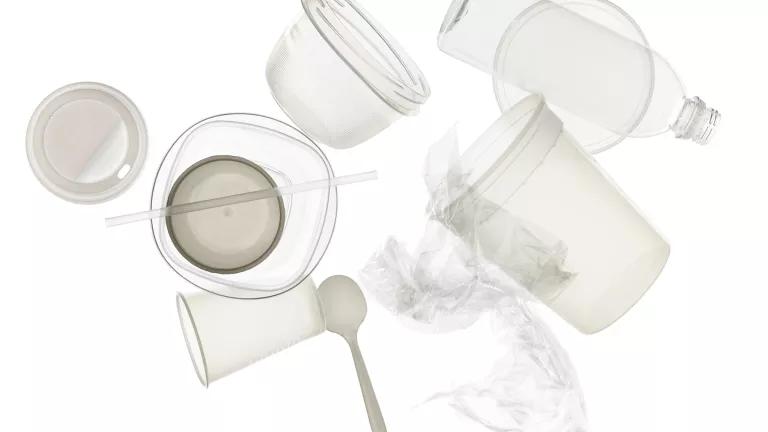4 Ways to Avoid Toxic Chemicals in Food Packaging
Despite what the industry will tell you, BPA is toxic. NRDC scientist Veena Singla wants it—and its equally poisonous replacements—out of our products.

To start with, can you tell me what BPA is and where it's used?
BPA is a manmade industrial chemical. It's a key building block in polycarbonate (no. 7) plastic, which is used to make a wide variety of products: water and juice bottles, food containers, CDs, DVDs, eyeglass lenses, and more. It's used in the lining of food and soda cans to prevent the contents from corroding the metal. BPA also serves as a "developer" in thermal paper receipts. These receipts aren't actually printed with ink; they're coated with chemicals that react to heat and change color to create the appearance of printed type.
Wow. BPA is in a lot of stuff. So how is it harmful to human health?
BPA is an endocrine disruptor. Endocrine disruptors are chemicals that are not naturally produced in our bodies but can mimic or block the action of our own natural hormones. BPA has been shown to mimic the female hormone estrogen. This upsets the normal processes of development (for growing babies and young children) and the functions necessary for maintaining an adult body.
In lab tests on animals early in life, BPA has been shown to cause altered brain development, reproductive abnormalities, and obesity, among other conditions. There is strong evidence that BPA is toxic to the ovaries and the uterus.
In May 2015, at the urging of state scientists and public-health advocates, including NRDC, California decided to add BPA to the list of chemicals known to cause harm to women’s reproductive health. Congratulations on a great science-based win! What happens next in that process?
Warning labels may be required on products that contain BPA, allowing consumers to make informed choices. And we'll probably see less BPA use in the future: When California lists a chemical as toxic, national companies that sell products there often just remove it from their manufacturing process to avoid having to develop two lines. For example, a common flame retardant was completely phased out of furniture after California added it to the toxic list.
I know NRDC previously helped get BPA out of a lot of baby products, such as bottles and sippy cups. But I've heard about a replacement called BPS. Is that just as bad? Where is it found?
Bisphenol S (BPS) and F (BPF) are chemicals similar to BPA that are sometimes used as substitutes. We don’t have many studies on them, but the existing data shows that BPS in receipts and BPF in food packaging (like can liners) are just as toxic as BPA.
It seems like we’re constantly playing whack-a-mole with toxic chemicals: Evidence shows one is really bad, and with help from groups like NRDC it gets phased out, but then the replacements are equally toxic. Is there any big-picture solution?
The root of the problem is an inadequate regulatory and policy framework for examining these chemicals before they’re put on the market. NRDC is pushing to reform and strengthen the Toxic Substances Control Act, or TSCA, to require the chemical industry to show that a substance is safe before putting it in everyday products. Real reform would also phase out toxic chemicals and ensure their replacements are safer. California is taking the lead on this at the state level with its Green Chemistry Initiative for consumer products, which was launched in 2013. That effort requires more data from manufacturers to ensure chemicals are safe and asks them to look for alternatives. The idea is to spark innovation in designing and promoting better chemicals to replace the toxic ones we use today.
For a consumer who wants to know more, it can get really overwhelming. Even the dust in my house has toxic chemicals in it! What do you suggest for people trying to avoid these toxics while staying sane?
You can’t really shop your way out of the problem, and it’s unfair to put all that responsibility on consumers. The change needs to happen at the policy level. We shouldn’t have to worry about whether what we buy is safe or not. But here are a few general rules of thumb.
- Buying food stored in glass jars is a good way to avoid BPA. Many products like soup broth now also come in BPA-free boxes.
- Instead of plastic reusable water bottles, use unlined stainless steel or glass.
- Say no thanks to paper receipts—a lot of stores will e-mail your receipt now.
- Wash your hands frequently and always before you eat. Chemicals in dust or on thermal paper receipts can get on your hands, and you don’t want that stuff in your mouth. It’s the same with your kids—try to wash their hands often throughout the day and always before they eat.
This NRDC.org story is available for online republication by news media outlets or nonprofits under these conditions: The writer(s) must be credited with a byline; you must note prominently that the story was originally published by NRDC.org and link to the original; the story cannot be edited (beyond simple things such as grammar); you can’t resell the story in any form or grant republishing rights to other outlets; you can’t republish our material wholesale or automatically—you need to select stories individually; you can’t republish the photos or graphics on our site without specific permission; you should drop us a note to let us know when you’ve used one of our stories.

Neonicotinoids 101: The Effects on Humans and Bees
A Growing Concern: Microplastic Pollution on Farm Fields
Murder Hornets Are Scary. But Pesticides Are Scarier.